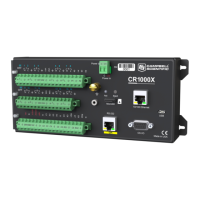hardware used for Modbus RTU, such as radios, must transfer data as entire packets without
injecting delays in the middle of Modbus messages.
l Modbus ASCII — Used in serial communications, data is transmitted as an ASCII
representation of the hexadecimal values. Timing requirements are loosened, and a simpler
longitudinal redundancy check checksum is used.
l
Modbus TCP/IP or Modbus TCP — Used for communications over TCP/IP networks. The
TCP/IP format does not require a checksum calculation, as lower layers already provide
checksum protection. The packet structure is similar to RTU, but utilizes a different header.
Devices labelled as Modbus gateways will convert from Modbus TCP to Modbus RTU.
Campbell Scientific dataloggers support Modbus RTU, Modbus ASCII, and Modbus TCP
protocols. If the connection is over IP, Campbell Scientific dataloggers always use Modbus TCP.
Modbus slave functionality over other comports use RTU. When acting as a master, the
datalogger can be switched between ASCII and RTU protocols using an option in the
ModbusMaster() instruction.
7.2.3 Understanding Modbus Terminology
Many of the object types are named from using Modbus in driving relays: a single-bit physical
output is called a coil, and a single-bit physical input is called a discrete input or a contact.
Information is stored in the slave device in up to four different tables. Two tables store on/off
discrete values (coils) and two store numerical values (registers). The coils and registers each have
a read-only table and read/write table.
7.2.4 Connecting Modbus devices
Dataloggers can communicate with Modbus on all available communication ports. Consideration
should be given to proper surge protection of any cabled connection. Between systems of
significantly different ground potential, optical isolation may be appropriate. For additional
information on grounds, see Grounds (p. 10).
The common serial interface used for Modbus RTU connections is RS-485 half-duplex, or two-
wire RS-485. This connection uses one differential pair for data, and another wire for a signal
ground. When twisted pair cable is used, the signal can travel long distances. Resistors are often
used to reduce noise. Bias resistors are used to give a clean default state on the signal lines. For
long cable lengths, termination resistors, which are usually 120 ohms, are needed to stop data
corruption due to reflections. Signal grounds are terminated to earth ground with resistors to
prevent ground loops, but allow a common mode signal. The resistors to ground are usually
integral to the equipment. The resistive ground is labelled as RG on Campbell Scientific
equipment.
7. Communications Protocols 85

